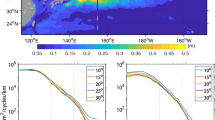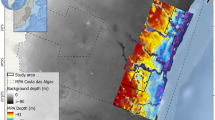Abstract
Radar imagery of shallow coastal waters (usually <40 m deep) contain unexplained features1–3 resembling the bottom topography. Since microwave radiation does not penetrate far in sea-water, these features must be the result of hydrodynamic processes coupled to the bottom topography that modulate the amplitude of the short (Bragg resonant) sea-surface waves, the main contributors to the backscattered radar power4,5. Because many different hydrodynamic processes operate in coastal waters, and the precise mechanism which generates the radar images is not fully established, a programme to explore the mechanism(s) was initiated at the US Naval Research Laboratory. Here we give a brief description of the possible mechanisms and results from the pilot experiment conducted in July 1982, 40 nautical miles south-east of Nantucket Island.
This is a preview of subscription content, access via your institution
Access options
Subscribe to this journal
Receive 51 print issues and online access
$199.00 per year
only $3.90 per issue
Buy this article
- Purchase on Springer Link
- Instant access to full article PDF
Prices may be subject to local taxes which are calculated during checkout
Similar content being viewed by others
References
De Loor, G. P. & Brunsveld Van Hutten, H. W. Bound-layer Met. 13, 119–131 (1978).
Beal, R. C., DeLeonibus, P. S. & Katz, I. Spaceborne Synthetic Aperture Radar for Oceanography (The Johns Hopkins Press, Baltimore 1981).
McLeish, W. et al. Mar. Geol. 43, M1–M8 (1981).
Wright, J. W. Bound.-Layer Met. 13, 87–105 (1978).
Keller, W. C., Plant, W. J. & Valenzuela, G. R. in Wave Dynamics and Radio Probing of the Ocean Surface (eds Phillips, O. M. & Hasselmann, K.) (Plenum, New York, in the press).
Zimmerman, J. T. F. Geophys. Astrophys. Fluid Dyn. 11, 35–47 (1978).
Robinson, I. S. Deep-Sea Res. 28 A, 195–212 (1981).
Longuet-Higgins, M. S. & Stewart, R. W. J. Fluid Mech. 10, 529–549 (1961).
Phillips, O. M. in Spaceborne Synthetic Aperture Radar for Oceanography (eds Beal, R. C., DeLeonibus, P. S. & Katz I.) 24–31 (The Johns Hopkins Press, Baltimore, 1981).
Komen, G. J. & Riepma, H. W. Geophys. Astrophys. Fluid Dyn. 18, 93–110 (1981).
Komen, G. J. & Riepma, H. W. Oceanol. Acta 4, 267–277 (1981).
Valenzuela, G. R. Radio Sci. 15, 105–114 (1980).
Alpers, W. R., Ross, D. B. & Rufenach, C. L. J. geophys. Res. 86, 6481–6498 (1981).
Plant, W. J. J. geophys Res. (in the press).
Author information
Authors and Affiliations
Rights and permissions
About this article
Cite this article
Valenzuela, G., Chen, D., Garrett, W. et al. Shallow water bottom topography from radar imagery. Nature 303, 687–689 (1983). https://doi.org/10.1038/303687a0
Received:
Accepted:
Published:
Issue Date:
DOI: https://doi.org/10.1038/303687a0
This article is cited by
-
Shear-flow induced secondary circulation in parallel underwater topographic corrugation and its application to satellite image interpretation
Journal of Ocean University of China (2012)
-
Satellite oceanography: Radar images of the sea bed
Nature (1985)
Comments
By submitting a comment you agree to abide by our Terms and Community Guidelines. If you find something abusive or that does not comply with our terms or guidelines please flag it as inappropriate.



